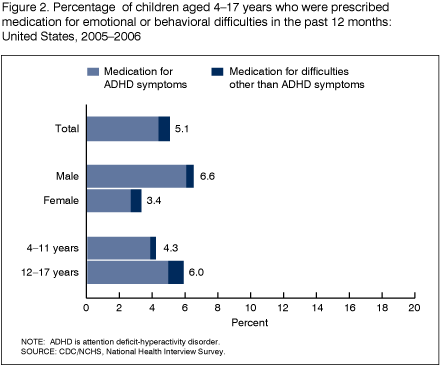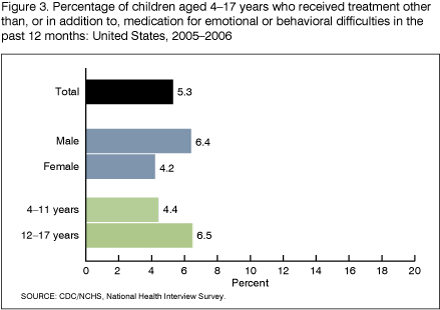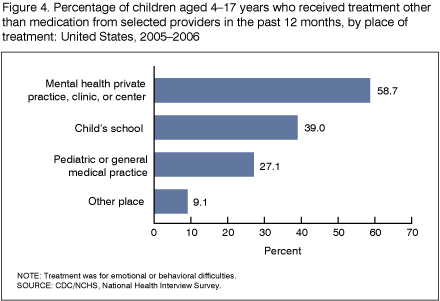Use of Mental Health Services in the Past 12 Months by Children Aged 4-17 Years: United States, 2005-2006
- Key findings
- How many children had parents who contacted health care providers or school staff about the child's emotional or behavioral difficulties?
- How many children were prescribed medication for emotional or behavioral difficulties?
- How many children (4-17 years) received treatment other than, or in addition to, medication for emotional or behavioral difficulties?
- Where do children receive treatment other than medication?
- Summary
- Definitions
- Data source and methods
- About the authors
- References
- Suggested citation
- Appendix
NCHS Data Brief No. 8, September 2008
by Gloria A. Simpson, M.A.; Robin A. Cohen, Ph.D.; Patricia N. Pastor, Ph.D.; and Cynthia A. Reuben, M.A.
PDF Version (806 KB)
Key findings
Data from the National Health Interview Survey
- In 2005-2006, 15% of U. S. children aged 4-17 years had parents who talked to a health care provider or school staff about their child’s emotional or behavioral difficulties. This included 18% of boys and 11% of girls.
- Approximately 5% of children were prescribed medication for difficulties with emotions or behavior. A large majority of these children (89%) were prescribed medication for difficulties with concentration, hyperactivity, or impulsivity, which are symptoms of attention deficit-hyperactivity disorder (ADHD).
- Approximately 5% of children received “treatment other than medication” for emotional or behavioral difficulties. Most of these children – 60% – received this treatment from a mental health private practice, clinic, or center.
(See Definitions for an explanation of emotional or behavioral difficulties.)
Mental health, which includes emotional and behavioral areas of health, is a critical component of child well-being. It may impact children’s physical health, relationships, and learning (1). Appropriate treatment and intervention for children with emotional or behavioral difficulties has been shown to lessen the impact of mental health problems on school achievement, relationships with family members and peers, and risk for substance abuse (1,2). Early mental health screening and the availability and use of appropriate mental health services are among the goals of the President’s New Freedom Commission on Mental Health (2).
Keywords: Mental health service use, treatment, medication, National Health Interview Survey
How many children had parents who contacted health care providers or school staff about the child’s emotional or behavioral difficulties?
Approximately 8.3 million children (14.5%) aged 4-17 years had parents who had ever talked with a health care provider or school staff about the child’s emotional or behavioral difficulties.

Boys were more likely than girls to have parents who had talked to a health care provider or school staff (17.6% compared with 11.2%).
Younger children (4-11 years) were as likely as older children (12-17 years) to have parents who had talked to a health care provider or school staff (14.5%).
How many children were prescribed medication for emotional or behavioral difficulties?
Approximately 2.9 million children (5.1%) were prescribed medication for such difficulties.

Boys were prescribed medication nearly twice as often as girls (6.6% compared with 3.4%).
Older boys (7.6%) were prescribed medication more often than younger boys (5.8%), and older girls (4.4%) were prescribed medication more often than younger girls (2.6%) (see Appendix, Table d).
Almost 9 in 10 children who were prescribed medication for emotional or behavioral difficulties received this medication for the symptoms of ADHD.
How many children (4-17 years) received treatment other than, or in addition to, medication for emotional or behavioral difficulties?
Approximately 2.9 million children (5.3%) received treatment other than, or in addition to, medication for such difficulties.

Boys (6.4%) and older children (6.5%) received treatment other than, or in addition to, medication more often than girls (4.2%) and younger children (4.4%).
One-half of the children who received treatment other than medication also received medication for these difficulties.
(See Definitions for treatment other than medication.)
Where do children receive treatment other than medication?
More than one-half of children received treatment other than medication at a mental health private practice, clinic, or center.

Almost 4 in 10 received treatment at the child’s school.
About one-quarter received these services from a pediatric or general medicine practice.
Nine percent received treatment other than medication from other places such as a center or clinic offering complementary or alternative medicine.
Approximately 5% of children received such services from more than one type of provider.
Summary
The emotional and behavioral difficulties of children are among the leading health concerns of U.S. parents. In 2005-2006, nearly 18% of boys and 11% of girls had parents who talked to a health care provider or school staff about their child’s emotional or behavioral difficulties. About 5% of children had been prescribed medication for these difficulties, and 5% had received treatment other than medication. Most children who received treatment other than, or in addition to, medication obtained these services from a mental health private practice, clinic, center, or the child’s school.
As the 2001 U.S. Surgeon General’s report on children’s mental health indicated, there is a current need for improved and expanded mental health services for children and adolescents (3). This report indicates the need for greater access to a variety of mental health services for children including both medication for emotional or behavioral difficulties and treatments other than medication. Recent research studies have documented the increased use of psychotropic medications (4). Less is known, though, about the use of nonmedication treatments for the emotional and behavioral difficulties of U.S. children. These treatments may include community-based services such as behavioral and family therapy provided by mental health professionals in clinic and office settings and school-based services such as assessments of mental health problems, individual counseling, and crisis intervention services for students (5,6). With the information collected by the mental health service questions in the National Health Interview Survey (NHIS), it will be possible to monitor future trends in the use of both medication and other treatments for the emotional and behavioral difficulties of children.
Definitions
Emotional or behavioral difficulties refer to difficulties with emotions, concentration, behavior, or being able to get along with others.
Parent talked to health care provider or school staff was based on a “yes” response to the question “Did you ever see or talk to any health care provider or school staff or personnel about difficulties {sample child’s name} has with emotions, concentration, behavior, or being able to get along with others?” and a response of “within the past 6 months” or “7 to 12 months ago” to the question “When was the MOST RECENT conversation or visit?” Responses to these questions do not indicate whether or not the child actually received treatment.
Prescribed medication was based on a “yes” response to the question “Was {sample child’s name} ever prescribed medication for difficulties with {his/her} emotions, concentration, behavior, or being able to get along with others?” and a response of “within the past 6 months” or “7 to 12 months ago” to the question “When was the MOST RECENT medication prescribed for these difficulties?”
Prescribed medication for difficulties with ADHD (difficulties with concentration, hyperactivity, or impulsivity) was based on meeting the criteria for the category “Prescribed medication” (see definition above) and a “yes” response to the question “Was this medication prescribed for difficulties with concentration, hyperactivity, or impulsivity?”
Received treatment other than, or in addition to, medication was based on a “yes” response to the question “Has {sample child’s name} EVER received ANY treatment or help, other than medication, for difficulties with emotions, concentration, behavior, or being able to get along with others?” and a response of “within the past 6 months” or “7 to 12 months ago” to the question “When was the MOST RECENT help or treatment received?” Examples of treatment other than medication include but are not limited to: behavioral therapy, family therapy, crisis intervention services, and complementary or alternative therapy such as acupuncture.
Data source and methods
Data from the 2005-2006 NHIS were used for this analysis. NHIS collects information about the health and health care of the noninstitutionalized population in the United States. Interviews are conducted in respondents’ homes primarily, but follow-ups to complete interviews may be conducted over the telephone. Questions about children’s use of mental health services are asked of parents of children aged 4-17 years in the sample child component of the survey. The questions about mental health service use that were first included in the 2005 NHIS were developed by the National Center for Health Statistics (NCHS) in collaboration with the Substance Abuse and Mental Health Services Administration (SAMHSA) and the National Institute of Mental Health (NIMH). The questions may be viewed on the NHIS website. In the 2005-2006 NHIS, 17,157 children aged 4-17 years were included in the sample child component of the NHIS.
NHIS is designed to yield a nationally representative sample, and this analysis uses weights to produce national estimates. Data weighting procedures are described in more detail elsewhere (7) (NHIS Methods). Point estimates and estimates of corresponding variances for this analysis were calculated using the SUDAAN software package (8) to account for the complex sample design of the NHIS. The Taylor series linearization method was chosen for variance estimation. All estimates shown meet the NCHS standard of having a relative standard error less than or equal to 30%. Differences between percentages were evaluated using two-sided significance tests at the 0.05 level. Terms such as “higher than” and “less than” indicate statistically significant differences. Terms such as “similar” and “no difference” indicate that the statistics being compared were not significantly different. Lack of comment regarding the difference between any two statistics does not necessarily suggest that the difference was tested and found to be not significant.
NHIS is conducted continuously throughout the year by interviewers of the U. S. Census Bureau for the Centers for Disease Control and Prevention’s NCHS. For further information about the NHIS see the NCHS website at the NHIS website.
About the authors
Gloria A. Simpson and Robin A. Cohen are with the Centers for Disease Control and Prevention’s National Center for Health Statistics, Division of Health Interview Statistics. Patricia N. Pastor and Cynthia A. Reuben are with the Centers for Disease Control and Prevention’s National Center for Health Statistics, Office of Analysis and Epidemiology.
References
- U.S. Department of Health and Human Services. Mental Health: A Report of the Surgeon General. Rockville, MD: Substance Abuse and Mental Health Services Administration, National Institutes of Health: National Institute of Mental Health. 1999.
- New Freedom Commission on Mental Health. Achieving the Promise: Transforming Mental Health Care in America. Final Report. July 2003.
- U.S. Public Health Service. Report of the Surgeon General’s Conference on Children’s Mental Health: A National Action Agenda. Washington, DC: Department of Health and Human Services. 2000.
- Martin A, Leslie D. Trends in psychotropic medication costs for children and adolescents, 1997-2000. Arch Pediatr Adolesc Med. 157:997-1004. 2003.
- Steele RG, Roberts MC (Eds.). Handbook of mental health services for children, adolescents, and families. New York: Springer, 2005.
- Foster S, Rollefson M, Doksum T, Noonan D, Robinson G, Teich J. School Mental Health Services in the United States, 2002-2003. DHHS Pub. No. (SMA) 05-4068. Rockville, MD: Center for Mental Health Services, Substance Abuse and Mental Health Services Administration. 2005.
- Botman SL, Moore TF, Moriarity CL, Parsons VL. Design and estimation for the National Health Interview Survey, 1995-2004. National Center for Health Statistics. Vital Health Stat 2(130). 2000.
- Research Triangle Institute. SUDAAN (Release 9.1). Research Triangle Park, NC: Research Triangle Institute. 2004.
Suggested citation
Simpson GA, Cohen RA, Pastor PN, Reuben CA. Use of mental health services in the past 12 months by children aged 4-17 years: United States, 2005-2006. NCHS data brief, no 8. Hyattsville, MD: National Center for Health Statistics. 2008.
Appendix
Table a. Types of services or help for emotional or behavioral difficulties received in the past 12 months by children aged 4-17 years: United States, 2005-2006
| Parent talked to health care provider or school staff1 | Prescribed medication2 | Prescribed medication for difficulties with ADHD3 | Received treatment other than, or in addition to, medication4 | |
|---|---|---|---|---|
| Percent (standard error)5 | ||||
| Total | 14.5 (0.35) | 5.1 (0.21) | 4.4 (0.20) | 5.3 (0.22) |
See footnotes at end of Table d
Table b. Types of services or help for emotional or behavioral difficulties received in the past 12 months by children aged 4-17 years, by age: United States, 2005-2006
| Age | Parent talked to health care provider or school staff1 | Prescribed medication2 | Prescribed medication for difficulties with ADHD3 | Received treatment other than, or in addition to, medication4 |
|---|---|---|---|---|
| Percent (standard error)5 | ||||
| 4-11 years | 14.5 (0.46) | 4.3 (0.26) | 3.9 (0.25) | 4.4 (0.26) |
| 12-17 years | 14.5 (0.51) | 6.0 (0.35) | 5.0 (0.32) | 6.5 (0.38) |
See footnotes at end of Table d
Table c. Types of services or help for emotional or behavioral difficulties received in the past 12 months by children aged 4-17 years, by sex: United States, 2005-2006
| Sex | Parent talked to health care provider or school staff1 | Prescribed medication2 | Prescribed medication for difficulties with ADHD3 | Received treatment other than, or in addition to, medication4 |
|---|---|---|---|---|
| Percent (standard error)5 | ||||
| Male | 17.6 (0.52) | 6.6 (0.34) | 6.1 (0.33) | 6.4 (0.34) |
| Female | 11.2 (0.44) | 3.4 (0.24) | 2.7 (0.21) | 4.2 (0.29) |
See footnotes at end of Table d
Table d. Types of services or help for emotional or behavioral difficulties received in the past 12 months by children aged 4-17 years, by age and sex: United States, 2005-2006
| Sex and age | Parent talked to health care provider or school staff1 | Prescribed medication2 | Prescribed medication for difficulties with ADHD3 | Received treatment other than, or in addition to, medication4 |
|---|---|---|---|---|
| Percent (standard error)5 | ||||
| Male 4-11 years | 17.7 (0.71) | 5.8 (0.43) | 5.5 (0.42) | 5.3 (0.37) |
| Male 12-17 years | 17.5 (0.76) | 7.6 (0.57) | 6.8 (0.55) | 7.8 (0.59) |
| Female 4-11 years | 11.1 (0.57) | 2.6 (0.30) | 2.3 (0.27) | 3.4 (0.36) |
| Female 12-17 years | 11.4 (0.66) | 4.4 (0.41) | 3.2 (0.32) | 5.2 (0.46) |
1 The category “Parent talked to health care provider or school staff” is based on a “yes” response to the question “Did you ever see or talk to any health care provider or school staff or personnel about difficulties {sample child’s name} has with emotions, concentration, behavior or being able to get along with others?” and a response of “within the past 6 months” or “7 to 12 months ago” to the question “When was the MOST RECENT conversation or visit?” Responses to these questions do not indicate whether or not the child actually received treatment.
2 The category “Prescribed medication” is based on a “yes” response to the question “Was {sample child’s name} ever prescribed medication for difficulties with {his/her} emotions, concentration, behavior or being able to get along with others?” and a response of “within the past 6 months” or “7 to 12 months ago” to the question “When was the MOST RECENT medication prescribed for these difficulties?”
3 The category “Prescribed medication for difficulties with ADHD” (difficulties with concentration, hyperactivity, or impulsivity) is based on meeting the criteria for the category “Prescribed medication” (see Footnote 2) and a “yes” response to the question “Was this medication prescribed for difficulties with concentration, hyperactivity, or impulsivity?”
4 The category “Received treatment other than, or in addition to, medication” is based on a “yes” response to the question “Has {sample child’s name} EVER received ANY treatment or help, other than medication, for difficulties with emotions, concentration, behavior, or being able to get along with others?” and a response of “within the past 6 months” or “7 to 12 months ago” to the question “When was the MOST RECENT help or treatment received?”
5 Unknowns for the column variables, which were less than 2%, are not included in the denominators when calculating percentages.
NOTE: Data are based on household interviews of a sample of the civilian noninstitutionalized population.
SOURCE: CDC/NCHS, National Health Interview Survey.